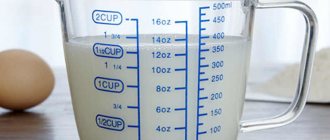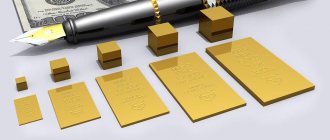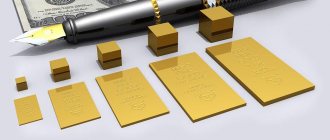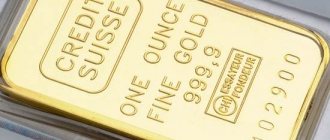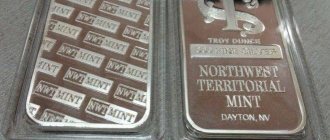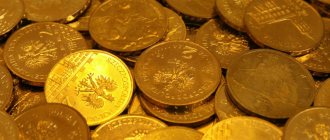Why, when analysts talk about the cost of the yellow metal, do they use the phrase “1 troy ounce of gold in grams”? Many are perplexed why, given the developed metric system of measures, such an inconvenient and archaic unit of measurement is still alive. Let's try to figure it out.
A troy ounce of gold (from the English troy ounce) is a unit of weight equal to 31.1034768 grams, but is often rounded to 31.1035 grams.
This unit of measurement is also used in the cosmetics industry to determine the weight of the most valuable ingredients. But this, of course, is not its main application.
The troy ounce is primarily indispensable (at least for now) for banking and jewelry in measuring the weight of precious metals and, accordingly, determining their value - silver, gold, platinum.
Where does the name of the unit of measurement come from?
The name of the troy ounce presumably comes from the French city of Troyes, a center of international trade known since the 9th century. The first mention of the troy ounce dates back to 1390. In Troyes, which at that time was one of the most important centers of trade in the world, a standard system of measures was introduced to simplify the exchange of goods between traders from different countries. The basis for the standardized measure of weight was the French livre, which included the troy pound of silver. Soon, by order of the English king with French roots, Henry II , troy units of measurement - grains, ounces and pounds - began to be used in England.
These weights were also used to weigh grain crops. In addition, the troy ounce was used by pharmacists at that time to determine the weight of drugs.
The previously existing Troyes system of measures is now outdated; troy ounces are actively used only in banking and jewelry as a noble standard for the weight of precious metals.
Troy ounce
The troy ounce is a generally accepted measure for precious metals.
Simplified value for translation: 1 ozt – 31.1035 grams .
It should be noted that in international trade this unit is used only to determine the mass of pure metals of the highest standard.
On world currency markets, the XAU index is used to indicate the rate of 999.9 gold. Mints in different countries mint coins weighing 31.1 g. Many, both old and modern money made of gold and silver, have this denomination.
We calculate the cost of gold according to its exchange rate
First, let's convert the cost of a troy ounce into rubles: 1310 x 65 = 85150 - the cost of one troy ounce in rubles in June 2022
A troy ounce is a unit of mass equal to 31.1 grams. As a unit of measurement, there is also the usual “Ounce”, which is equal to 28.35 grams, but in international trade in precious metals it is the troy ounce that is used.
But, we count the cost of gold not in ounces, but in grams. Therefore, we divide the cost of an ounce by the number of grams it contains:
85150 / 31,1 = 2738 — the cost of one gram of pure gold in June 2022
You didn’t think that the 585 breakdown would be traded on the international market, did you? Now, knowing the cost of one gram of 999 fine gold, we only need to calculate the price of the sample we need.
To do this, you just need to divide the sample you need by 999..
585 / 999 = 0,585 — this is the coefficient necessary to determine the value of 585 gold
Now we multiply this figure by the cost of 1 gram of pure gold.
0.585 x 2738 = 1602 - the cost of 1 gram of 585 gold at the exchange rate as of June 1, 2022
And for my laziest readers, I made an automatic calculation of the value of gold at its current rate . Add this page to your bookmarks and you will be able to see the price of gold at any time.
From the history of the use of an ounce
The concept of "ounce" comes from the Latin word "uncia", which literally means "a little thing, a little bit, a little bit." This designates several units of measurement of mass, it is also the definition for a couple of measures of liquid volume, is used as a unit of measurement of force, and even as the name of several monetary units (including gold and silver).
This term was used back in ancient Rome. There, 1 ounce meant 1/12 of a libra, an ancient Roman measure of weight equal to 327.45 g (or 0.7996 Russian pounds). Libra was most often used to indicate how much precious metals, particularly gold, weigh. In this case, an ounce, indicated by the sign “I”, a dot (•) or a horizontal line (-), was equal to 28.34 g (0.0666 Russian pounds) and was divided into 2 semuntia (Σ, Є, £), 4 sicilicus ( Ɔ), 6 sextula (Ƨ), 24 scruples (E) and 144 siliqus.
This measurement system was applied not only to metals. The Romans used it for a number of other various purposes. For example, to indicate the size of an inheritance, a measure of capacity, length (where 1 ounce was equal to 0.0246 m) and surface area (where 1 ounce was equal to 209.91 m²).
Later, such a measurement system was borrowed from the Romans by almost all the peoples of medieval Europe and, before the introduction of the metric system of measures, it was one of the main and most widespread.
In Italy, an ounce was equal to 1/12 of a pound, in Portugal and Spain 1/16 of a trade pound. In Sicily (until 1865) this was the name of a coin unit identical to 2½ scudi (a silver and gold coin in Italy, equal to 5 francs) or 3 ducats (the name for silver (since 1140) and then (since 1284) gold coins, first appeared in Italy, and later produced in a number of other European countries).
In Latin America and Spain, the gold coin doubloon was called this way. In China - tael (or liang - a measure of weight and monetary unit in Southeast Asia).
Translation problems
Translation problems arise due to the presence of different names depending on the field of use and the country where it is used. Adding to the confusion is the fact that some countries, such as the United States, still do not use the metric system, preferring the traditional one.
- Avoirdupois (oz or oz at) – 28.35 g, used by the USA as a measure of weight.
- Fluid ounce (fl oz) – 29.573 531 ml, used to determine the volume of liquid.
- Troy ounce (toz or ozt) – 31.1034768 g, this value is used throughout the world to measure the weight of precious metals.
What is measured in troy ounces?
The weight of precious metal coins issued by central banks is measured in fractions of a troy ounce. For example, in the United States, American Eagles have been minted since 1986 - an official means of payment recognized in the world precious metals market. The coins are available in four denominations: 1/10, 1/4, 1/2 and 1 ounce. Based on the Gold Weight Coin Act, the gold content of the coins is guaranteed by the US government. Thus, a gold coin weighing 1 ounce, i.e. 31.104 grams, weighs a total of 33.931 grams. It has a diameter of 32.70 millimeters and a thickness of 2.87 millimeters.
Most modern coins are produced from various alloys that contain one or another proportion of precious metal. In Russia, grams are usually used to indicate the weight of a coin, but the precious metal content always corresponds to a certain fraction of a troy ounce. Thus, the gold commemorative coin “St. George the Victorious” with a face value of 50 rubles, issued by the Bank of Russia, weighs 7.89 grams, the mass of pure gold in it is at least 7.78 grams, which is 1/4 troy ounce. And the silver “St. George the Victorious” with a face value of 3 rubles weighs 31.5 grams, the mass of pure silver in the coin is at least 31.1 grams, i.e. approximately one troy ounce.
How much is gold worth
Ounces and grams
One troy ounce of 999 fine gold = 31.1034768 grams
A gold troy ounce has the following designations:
ozt
(tr.oz, t oz),
XAU
For simplified calculations, the value is usually used:
1 ozt = 31.103 grams.
The Central Bank of the Russian Federation recalculates quotes into rubles and grams at its US dollar to Russian ruble exchange rate valid on the day following the day the discount prices are established. The official price of a gram of gold in Russian rubles, effective today: Central Bank rate (On the website of the Central Bank in the section “Account prices for refined* precious metals.” *Refined means purified from impurities to the maximum possible extent.)
Gold containing 99.99% of the precious metal - the so-called 999 fineness - is traded on exchanges. Refined precious metals (in the form of bars, investment coins, in metal accounts) are purchased by companies and individuals for investment purposes. Jewelry gold of various samples (750, 585...) - alloys of noble metal with alloy (additives) in different proportions - is bought mainly for its intended purpose - as jewelry; however, it always remains a liquid financial asset, if not by definition, then in essence.
Exchanges and the Central Bank are the main guidelines Every day on weekdays, the Central Bank of Russia sets the “account price” for gold (as well as other precious metals). This price is used by banks for accounting purposes. It is also called the “second price” because it is calculated based on quotes from the world’s main exchanges - the LME (London Metal Exchange) and COMEX (New York Mercantile Exchange), where the “first price” is formed in US dollars per troy ounce of precious metal.
“Expensive” and “cheap” samples
As you know, gold comes in different grades, differing in greater or lesser percentage of additives in the noble alloy. It is clear that the more additives, the cheaper the gold alloy.
| Try | Au content |
| 958 | 95,8 % |
| 750 | 75 % |
| 585 | 58,5 % |
| 500 | 50 % |
| 375 | 37,5 % |
The first idea of the “reasonableness” of the price of a gold product can be made by comparing its present value per gram with the discount price of the Central Bank. A simple formula is used for this: The book price of 1 gram according to the Central Bank X (multiplied) by the percentage of Aurum content in the alloy
. The most popular and popular samples among buyers are 750 and 585. For the first of them, the “real” price per gram will be three quarters of the Central Bank discount price, for the second a little more than half...
Spread and margin
The “real” price can serve as a guide, but you will never be able to buy or sell for it, because there are such concepts as spread and margin. The spread is the difference between the purchase and sale prices, and the margin is the material interest that remains with the organization making the sale or purchase. These values are partly determined by the “technical” costs of conducting transactions, but to a large extent by the market situation and the pricing policy of companies. From this follows a seemingly obvious, but nevertheless very important conclusion to follow: the most profitable purchase can be made by carefully studying the offers on the market. This remark applies to absolutely all types of transactions with Au - be it filling a virtual metal account or buying jewelry, coins, bars... As for bars and jewelry, the margin is additionally influenced by the features of the “production process”. Larger bars are more profitable to buy; their price per gram will be lower. And the cost of jewelry is affected by the premium for artistry; The works of renowned masters will be especially expensive. But when selling, in neither the first nor the second case, the buyer’s additional expenses will most likely not be taken into account. Buyers of bullion will also have to pay VAT. This leads to an increase in acquisition costs by 18%. True, the Ministry of Finance recently initiated the abolition of this tax. Whether this will actually happen, time will tell. Moneyinformer will monitor developments.
Good timing
In the long term, investing in gold will definitely pay for itself. If you look at the graph of price dynamics over the past 20 years, you can see that the cost of this metal has increased several times. Another thing is that it is impossible to predict how long an upward or downward trend will last. Until now, for example, the maximum of mid-2011 has not been reached again, and about 10 years have passed since then. Therefore, buying Aurum in the hope that after some time it will be possible to sell it at a profit is an extremely risky strategy. But the strategy of a “safe haven”, a protective asset, is widely used - transferring savings or part of them into gold in order to protect them to the maximum extent possible from the influence of economic crises, the volatility of national currencies and other factors that threaten them. This is exactly the strategy that the Russian Central Bank followed before the crisis began in 2022, increasing its gold and foreign exchange reserves. More details
In the pawnshop and buying
The price of gold in a pawnshop is more predictable and understandable in its formation than, for example, the cost of bullion in banks. Above, Moneyinformer provided a formula for calculating the “real” (fair) value of a gram of precious metal. In the “best” pawn shops, when buying gold items, they pay 80-100 rubles per gram. less than it, and when selling, on the contrary, they add the same or slightly less amount. We are talking here specifically about buying (issuing a loan secured by) scrap gold, and most of the products accepted for commission, including those with precious stones, are recognized as such. Products recognized as jewelry, having jewelry, artistic or historical value (they must be in good condition) can be purchased (accepted as collateral) at a higher price. However, it will be limited to an amount that, as a rule, does not exceed double the price of scrap, no matter how wonderful the gold product is. Naturally, it makes sense for sellers of such products to first contact specialized stores. If a pawnshop client intends to buy back the item handed over in the future, when calculating the cost, he must take into account that he will be charged interest on the loan, which differs in different pawnshops, but, as a rule, is considerable. The actual amounts received by pawnshop clients for their belongings may be less than expected or even declared by appraisers, since employees of these organizations often use unscrupulous work methods. Among them are various deductions from the amount paid to the client - for losses during metal remelting, for dirt on the products, for the absence of an assay office stamp, VAT (should not be charged to the client) ... It is also advisable to know the exact weight of your product in order to avoid weight gain. The final price should be clarified before signing the contract, and if you do not agree with it, try to look for a company with a more acceptable service.
Who today determines the cost of one troy ounce?
The price for one troy ounce of gold is set by one of the oldest trading platforms in the world: the London Metal Exchange. Price fixing - the well-known London fixing - occurs twice a day: at 10:30 and in the afternoon, at 15:00 London time.
The London Stock Exchange determines the price of gold based on the results of two trading sessions, which are held from 11:40 to 14:45 and from 14:55 to 17:00.
The price of gold on the London Stock Exchange plays a decisive role in setting the price of precious metals on world exchanges, and also serves as an indicator of the state of the world economy. Based on these data, analysts make assumptions regarding exchange rates and the value of various minerals on the world market.
Recently, the price of gold has been rising. Since March 2022, its price has increased by more than 21%. Amid the pandemic and the weakening dollar, investors are investing in the precious metal because they consider it the safest asset.
Forecast: by the end of 2012, gold will rise to $1,900 per ounce
According to specialists at HSBC Bank, one of the largest in Britain, investors can count on gold. This will be one of the assets that will benefit from the current political and economic crises in the United States. Experts believe that in the fall the price of gold may reach 1900 troy ounces, which, in turn, may increase gold production. Supporting Gold Price Facts:
- economic uncertainty;
- presidential elections in November in the states.
An HSBC report suggests gold prices will rise to more than $1,900 an ounce by the end of the year as its price could rise due to uncertainty over the fate of the dollar and euro. However, experts recommend that central banks and governments take steps to ensure the stability of their country's currency.
Using recalculation in practice
The need to convert ounce to gram arises, in most cases, when trying to calculate how much gold or silver costs per gram in national currency, for example in rubles, today. The calculation algorithm is quite complex and requires knowledge not only of the cost of the metal in dollars per ounce, but also of the ruble/dollar exchange rate. It looks like this:
the cost of gold (USD/ozt) divided by 31.1035 and multiplied by the exchange rate USD/RUB, we get the price of gold in RUB/g.
There is a calculator for calculating the cost of gold, which makes calculations based on data from the Central Bank, which makes it much easier and faster to get the desired result.
You can find a large number of unit converters on the Internet; when using such programs to convert the weight of precious metals, it is important to remember that you need a troy ounce, and not some other unit.
Where to watch the gold rate
The international currency used by players in the precious metals market is the dollar. And therefore, to calculate the cost of gold, you need to take into account the dollar exchange rate to your currency.
The gold rate changes every day, as does the value of the dollar. Therefore, to calculate the price of the precious metal, we need the current exchange rate of not only gold, but also the dollar.
The value of the dollar can be found on the Central Bank website. The gold rate in Russia is usually calculated according to the London Gold Exchange (LBMA).
But, you can make it easier and go to the Yandex website in the News section.
In the Economy tab we will immediately see the dollar to ruble exchange rate.
In June 2022, 1 US dollar is equal to 65 rubles.
Next we need to click on the “Raw Materials” tab and select “Gold”
In June 2022, the gold rate is $1,310 per 1 troy ounce.
How is the price of a troy ounce formed?
How much gold and silver cost now depends on many factors. The cost is based on:
- the state of the world economy;
- supply, demand, speculation on the part of major market participants;
- production volume;
- prices for oil and other energy resources;
- crises, both economic and political;
- existing military conflicts;
- inflationary processes;
- dollar exchange rate.
Fixing on the stock exchange is determined as a result of trading in which more than 150 companies participate. Members of the LMBA association are the largest banks, enterprises, miners, manufacturers, companies for the transportation and storage of precious metals, and traders.
